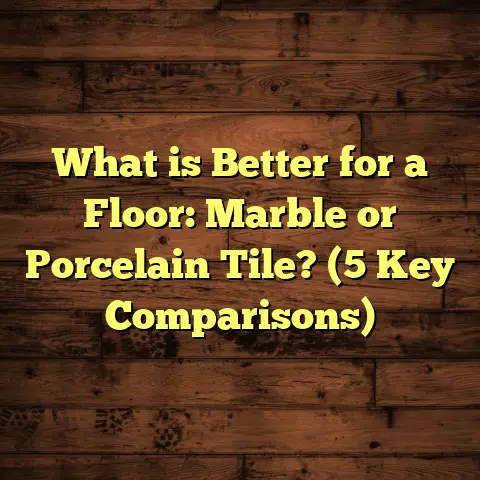What is on the Floor in Westminster Abbey? (5 Treasures Unveiled)
I can’t help but feel a rush whenever I think about the exquisite flooring of Westminster Abbey. If you’ve ever walked through those hallowed halls, you know there’s something special beneath your feet. The Abbey isn’t just a stunning architectural masterpiece; it holds a treasure trove of history within its floors. Today, I want to share some incredible insights into the five remarkable treasures that lie on the floor of Westminster Abbey, and trust me, these aren’t just your average floor tiles.
The Intriguing Stone Tiles
The first treasure that captures my heart is the stone tiles. These aren’t just any ordinary tiles; they date back hundreds of years and were laid with meticulous care. The floor is predominantly made up of Purbeck marble and various other stones, each chosen for their aesthetic and historical significance.
Imagine standing on stones that have been walked over by kings, queens, and dignitaries for centuries! I remember my first visit to the Abbey; I felt an overwhelming sense of connection to history as I stood on those ancient stones. The craftsmanship is incredible, and every crack and crevice tells a story.
Historical Context of Stone Tiles
The use of stone in Westminster Abbey’s flooring reflects not only artistry but also the durability that is needed in a space frequented by thousands each year. Purbeck marble, sourced from the Isle of Purbeck in Dorset, has been used since the 12th century. It is a dense limestone that can withstand the test of time, making it ideal for such an important location.
The stone tiles were often laid in intricate patterns, which served both aesthetic and functional purposes. These patterns can be traced back to medieval designs, where geometry held significant meaning in architecture and spirituality. Walking over these stones feels like stepping back into history—a tangible connection to the past.
Installation Insights
When it comes to installing stone tiles like those found in Westminster Abbey, it’s crucial to ensure proper subfloor preparation. A level and sturdy base is essential to prevent cracking and shifting over time. I often recommend using a thin-set mortar specifically designed for natural stone, as it offers better adhesion and flexibility.
During installation, one must also consider the layout. Many stone floors in historical buildings utilize a radial pattern that draws the eye to focal points like altars or tombs. This method not only enhances beauty but also guides visitors through the space.
Maintenance Tips
Maintaining these beautiful stone tiles requires regular cleaning and sealing to protect against stains and wear. I’ve found that using a pH-neutral cleaner keeps the gloss without damaging the stone’s surface. Sealing should be done every couple of years to maintain its luster.
In my own experience with stone flooring at home, I’ve learned that it’s essential to avoid acidic cleaners, as they can etch the surface of natural stones. Instead, gentle soap and water work wonders for routine cleaning. I also recommend placing mats at entrances to trap dirt before it reaches your beautiful stone floors.
The Magnificent Memorial Slabs
Next up are the memorial slabs that adorn the floor. These slabs are not just decorative but serve as tombstones for some of Britain’s most notable figures, including scientists, poets, and statesmen. Walking over these slabs felt like walking through history itself, each name etched into the stone a reminder of their contributions.
Unique Insights
Did you know that some of these memorials are made from different types of stone? For example, the memorial for Sir Isaac Newton is crafted from black marble, which adds a striking contrast to the lighter stones surrounding it. This variety not only highlights the importance of the individuals buried beneath but also enhances the visual appeal of the floor.
Many slabs commemorate individuals with significant contributions to British society and culture. The poet Geoffrey Chaucer, known for “The Canterbury Tales,” is one such figure whose memorial slab lies within the Abbey. His legacy continues to influence literature today.
Installation Considerations
When installing memorial slabs, precision is key. Each slab must be aligned perfectly to maintain the overall aesthetic of the Abbey’s floor. I recommend using laser levels during installation to ensure everything is straight and true.
Moreover, it’s important to respect the historical context during installation. In some cases, restorers face dilemmas regarding whether to replace worn-out slabs or preserve them as they are. In my view, striking a balance between maintaining authenticity and ensuring safety for visitors is crucial.
Caring for Memorial Slabs
Caring for these memorials is particularly important since they carry historical weight. Regular dusting and gentle cleaning with a damp cloth are essential. Avoid harsh chemicals that could damage the stones; instead, opt for gentle stone-safe cleaners.
I once attended a ceremony at Westminster Abbey that brought together descendants of some notable figures buried there. It was fascinating to hear their stories and their desire to keep these memorials pristine. Their dedication serves as a reminder that we are all custodians of history in our own way.
The Stunning Mosaic Patterns
One of my personal favorites among the treasures is the intricate mosaic patterns woven into the floor design. These mosaics are not just visually stunning but also serve to symbolize various aspects of faith and history. They can be spotted throughout different areas of the Abbey, adding depth and character to each space.
The Artistic Significance
The mosaics often incorporate symbols from Christianity, such as crosses and doves, along with intricate geometric shapes. Research has shown that these designs were deliberately placed to guide visitors’ spiritual journeys as they move through the space. It’s fascinating how art can influence feelings and perceptions!
Mosaics have been used throughout history to convey stories, beliefs, and values. In many ways, they serve as visual narratives that can be interpreted by viewers. I once found myself drawn into a specific mosaic design that depicted scenes from biblical stories; it prompted me to reflect on my own beliefs and experiences.
Installation Techniques
Installing mosaics requires patience and a keen eye for detail. I always recommend starting from the center of the design and working outward to ensure symmetry. Using mesh backing can simplify installation, especially with more complex designs.
In my experience with mosaic installations at home, I’ve found that using a wet saw is invaluable for precision cutting. It minimizes chipping and ensures clean edges—essential for achieving that polished look that makes mosaics so appealing.
Maintenance Recommendations
Mosaic floors require special care due to their intricate nature. Regular sweeping to remove debris is essential, along with occasional deep cleaning using a steam cleaner designed for delicate surfaces. This not only keeps them looking pristine but also helps maintain their structural integrity.
I’ve also discovered that sealing grouting between mosaics can prevent stains from seeping in—a tip I wish I had learned earlier during my own remodeling projects!
The Rich History Beneath Our Feet
Another remarkable aspect of Westminster Abbey’s flooring is its rich history embedded in every inch. Did you know that some sections date back to the 13th century? As I walked through the Abbey, I couldn’t help but wonder about all the events that had taken place on these very floors—coronations, funerals, and weddings.
Key Historical Events
The significance of Westminster Abbey goes far beyond its physical structure; it’s woven into the fabric of British history itself. The Abbey has hosted numerous royal events, including coronations since 1066 when William the Conqueror was crowned King of England. Each ceremony has left its mark on both history and the floors themselves.
During my visits, I’ve been struck by how many pivotal moments occurred right where I stood. From Queen Elizabeth I’s funeral to Charles Darwin’s memorial service—it’s hard not to feel overwhelmed by the weight of history pressing down beneath your feet.
Installation Insights
When considering historical flooring projects like those at Westminster Abbey, understanding its past is vital in any restoration or maintenance efforts. For instance, if you’re working on a similar project at home that involves historical materials or styles, always consult preservation specialists who can guide you on best practices.
In my work as a contractor, I’ve often encountered clients who wish to integrate historical elements into modern designs. One approach I love is using reclaimed materials that honor traditional styles while fitting seamlessly into contemporary spaces.
The Artistry of Woodwork
Finally, let’s talk about the wooden elements in Westminster Abbey’s flooring. While much of it is stone-based, there are remarkable wooden sections that showcase exquisite craftsmanship. The combination of wood and stone creates a beautiful contrast that enhances the overall aesthetic appeal.
Types of Wood Used
The wood used in certain areas includes oak and cedar, each selected for its durability and beauty. Oak has long been favored in construction due to its strength—it can withstand heavy foot traffic without showing wear easily.
I fondly recall one moment when I marveled at how well-preserved these wooden elements are despite their age. During my last visit, I asked one of the guides about their maintenance routine; they mentioned regular polishing with natural oils helps keep the wood looking vibrant.
Installation Best Practices
Installing wood flooring in high-traffic areas like a church requires careful consideration of wood type and finish. I often advise using engineered wood in such cases since it can withstand moisture fluctuations better than solid wood.
Additionally, understanding how wooden elements expand and contract with temperature changes is crucial for long-lasting results. When installing wood flooring in a place like Westminster Abbey, acclimating the wood before installation ensures it adapts properly to its environment.
Maintenance Essentials
Wood needs special attention—regular polishing helps maintain its shine while protecting against scratches. I always suggest using a soft cloth along with a wood-safe cleaner to keep it looking new.
In my own home renovation projects, I’ve learned how valuable it is to establish a regular maintenance schedule for wood floors—this not only prolongs their life but also enhances their beauty over time.
Exploring Additional Treasures
While I’ve focused on five main treasures within Westminster Abbey’s flooring, there are countless other elements worth exploring—each contributing its unique story to this iconic site.
The Floor Plan: An Architectural Masterpiece
One aspect often overlooked is how the floor plan itself tells a story through its layout. The design incorporates various sections dedicated to different purposes—each area possessing its own unique character.
When I first studied architectural designs for historical buildings like this one, I was amazed by how well thought out everything was—from traffic flow to acoustics—every detail matters!
The Influence of Natural Light
Another beautiful feature of Westminster Abbey’s architecture is how natural light interacts with the flooring materials throughout different times of day. The interplay between light and shadow adds depth to both stone and wood surfaces—transforming them as daylight shifts from dawn till dusk.
On my visits, I’ve often found myself captivated by how sunlight streaming through stained glass windows creates colorful reflections on the floor below—a breathtaking reminder of how art can enhance our connection with sacred spaces.
Personal Anecdotes: My Journey with Flooring
Reflecting on my journey as a flooring contractor, I realize how much I’ve grown through experiences similar to those at Westminster Abbey—each project presenting unique challenges and opportunities for learning.
One memorable project involved restoring an old church where we uncovered stunning original wooden floors hidden under layers of carpet! It reminded me of my visits to Westminster Abbey—the thrill of revealing hidden beauty within historical structures fuels my passion for flooring work.
Lessons Learned Along The Way
Every project teaches me new lessons—like the importance of respecting historical integrity when working with aged materials or finding innovative solutions for modern needs without compromising classic aesthetics.
As I share this journey with you today about Westminster Abbey’s flooring treasures—remember that every space holds stories waiting to be discovered! Whether you’re considering your home renovation or exploring architectural wonders around you—take time to appreciate each detail!
Conclusion: A Call To Appreciate Our Floors
As I wrap up my thoughts on what lies beneath our feet at Westminster Abbey, it’s clear that each treasure contributes not only to the beauty but also to the depth of history that permeates this iconic structure. Whether it’s the stone tiles that tell tales of yore or the memorial slabs honoring great minds, every inch is steeped in significance.
Next time you step into such a historical site or even consider your own flooring choices at home, remember the stories behind them. They might just inspire you as much as they did for me!





